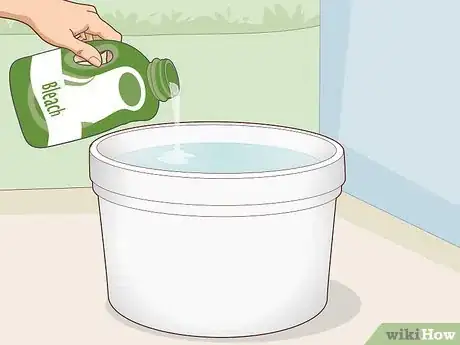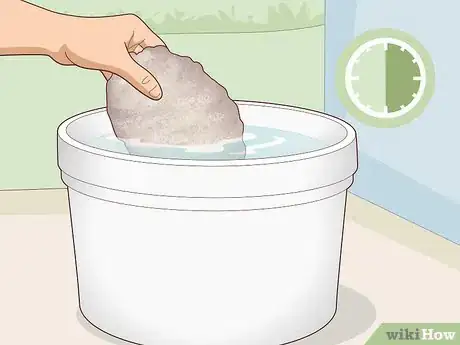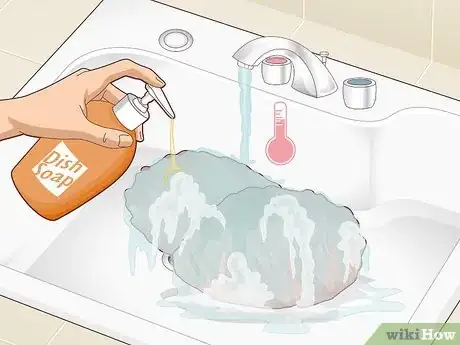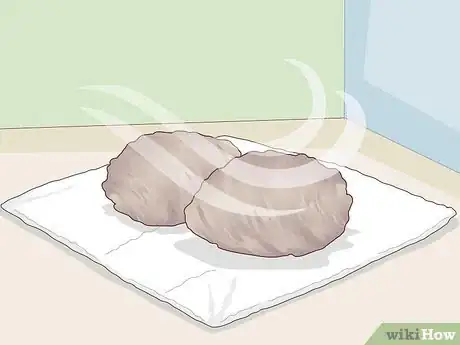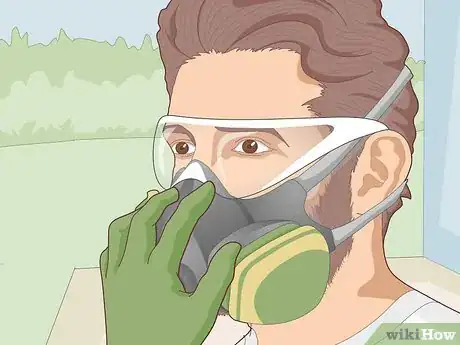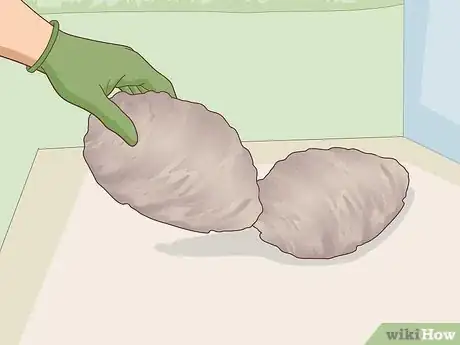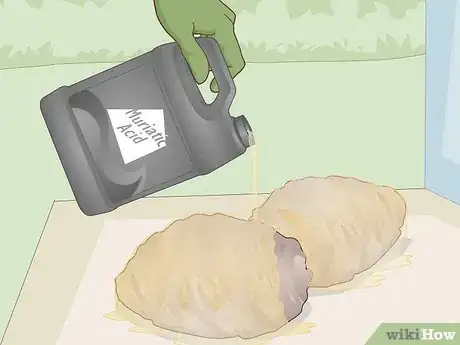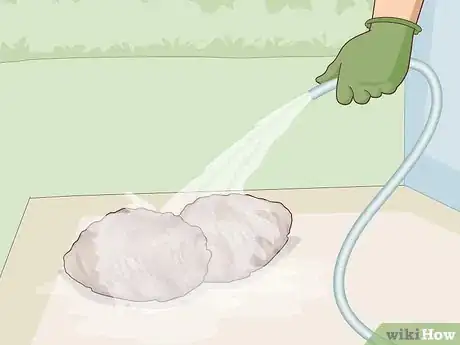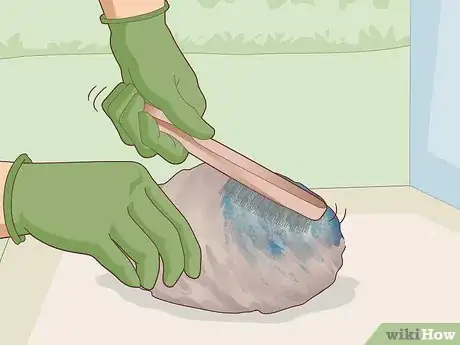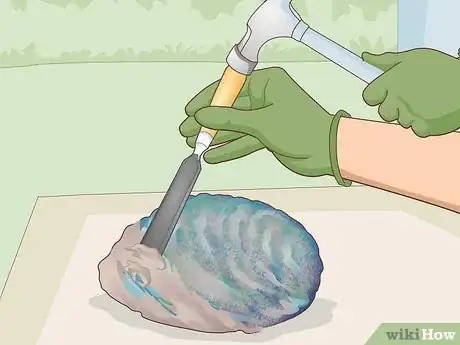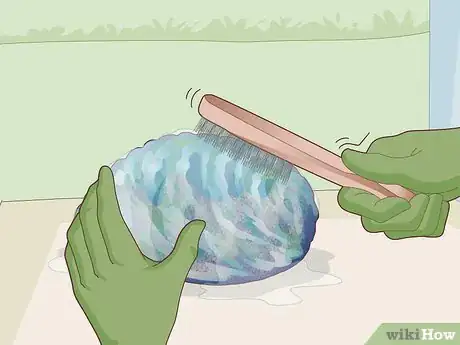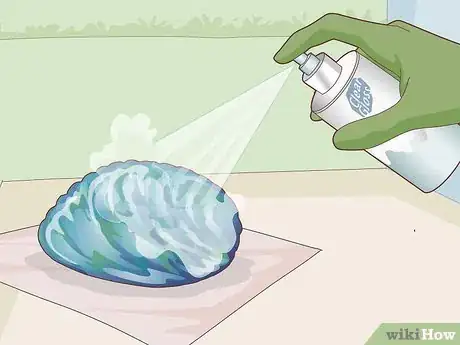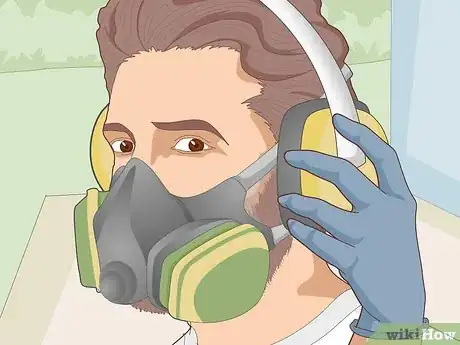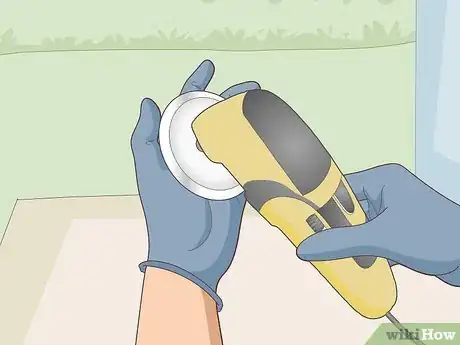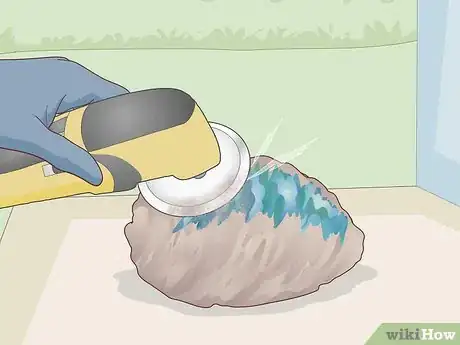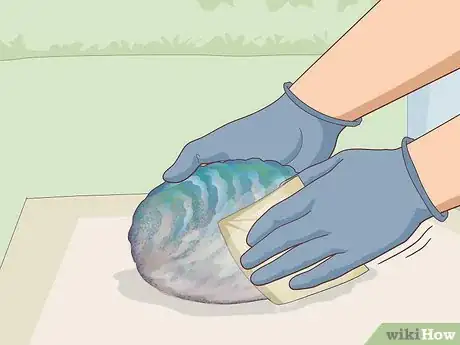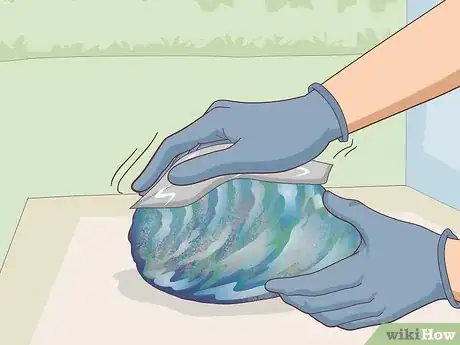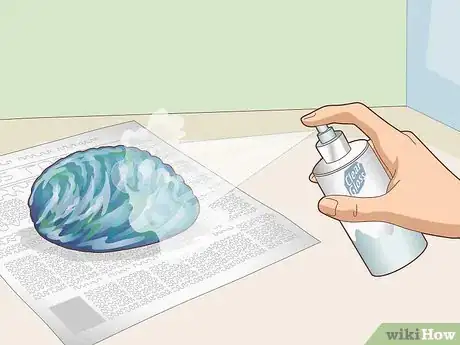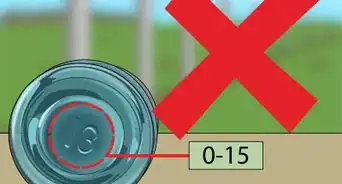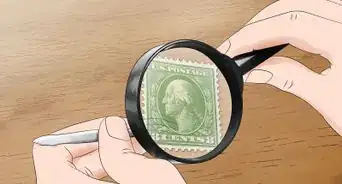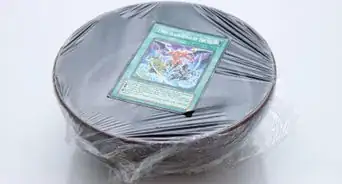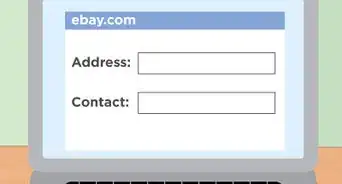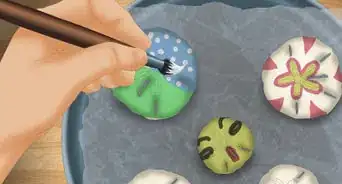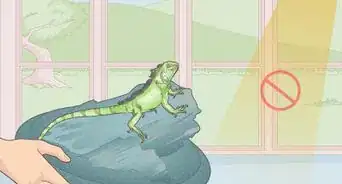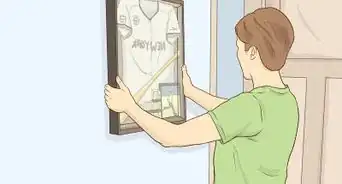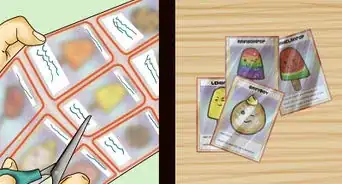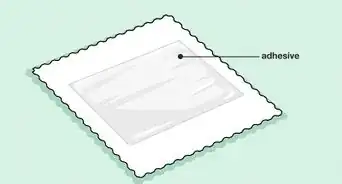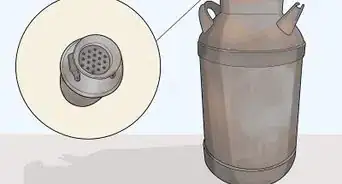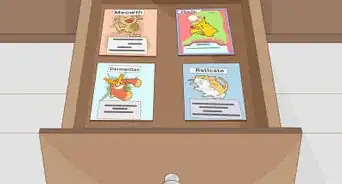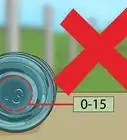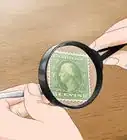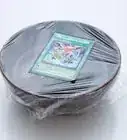This article was co-authored by wikiHow Staff. Our trained team of editors and researchers validate articles for accuracy and comprehensiveness. wikiHow's Content Management Team carefully monitors the work from our editorial staff to ensure that each article is backed by trusted research and meets our high quality standards.
There are 22 references cited in this article, which can be found at the bottom of the page.
This article has been viewed 27,469 times.
Learn more...
Paua (also known as “abalone” in the U.S. and Australia and “ormer” in the U.K.) is the Māori name for several species of large, edible sea snails. While paua is most commonly viewed as food in coastal regions, it is also prized by some collectors for its iridescent shell, which glimmers with brilliant red, golden, and blue-green hues when properly cleaned and polished.
Steps
Disinfecting Paua Shells with Bleach
-
1Mix up a diluted bleach solution in a bucket or similar large container. Fill your container with 3–5 gallons (11–19 L) of clean water, then pour in roughly 1–2 cups (240–470 mL) of bleach. The two liquids will create a mild soaking solution that’s strong enough to rid your paua shells of bacteria without causing weathering or other damage.[1]
- Anytime you’re working with bleach, you’ll want to slip on some rubber or nitrile gloves to protect your skin from irritation.[2]
- Add the bleach to the water, not the other way around. This will cut down on the amount of harmful fumes circulating throughout your work area.
-
2Soak your paua in the bleach solution for a minimum of 30 minutes. For best results, let them sit for several hours, or even overnight. The bleach will sterilize the shells gradually as they soak while also loosening stuck-on grime, brightening their vivid hues, and neutralizing any unpleasant fishy smell.[3]
- Make sure the shells are completely submerged in the solution. This may require you to tinker with the quantities of water and bleach you use, depending on the size of your container and the number of paua you’re cleaning.
Alternative: If you’re worried about the bleach muting the colors of your paua, simply fill your container with tap water and soak the shells for up to a week, then boil them briefly to kill off any lingering germs.[4]
Advertisement -
3Wash the bleached shells with warm, soapy water. After allowing your paua to soak for your preferred length, remove them from the solution and take them to the sink in your kitchen or bathroom. Rinse each shell under the faucet for a few seconds to remove the excess bleach, then gather them up and swish them through a separate container filled with warm water and mild liquid dish soap.[5]
- Remember to wear gloves when retrieving your shells from their soaking container. You can also fish them out with a pair of metal tongs to decrease your risk even more.
- Rinse the shells thoroughly for a second time following their soapy water bath. Any traces of soap left on their outer surfaces could dry into a cloudy film.
-
4Allow the shells to air dry. Find an out-of-the-way spot with good ventilation in or near your home and stretch out an absorbent towel. Arrange your paua on the towel with their exterior surfaces facing outward, leaving at least 1⁄2 inch (1.3 cm) of space between each shell. They should dry completely within a few short hours.[6]
- It’s okay to dry paua shells outdoors, but keep them out of direct sunlight. Prolonged exposure to intense UV rays could leach some of their handsome coloration.[7]
Scrubbing Shells with Muriatic Acid
-
1Pull on a facemask or respirator, a pair of gloves, and some eye protection. Muriatic acid is extremely potent, and could cause chemical burns if it happens to come into contact with your skin. For this reason, it’s important to make sure that you’re well-protected before you get started.[8]
- It’s also a good idea to wear long-sleeved clothing and closed-toed shoes to prevent any acid from getting on your skin.
- You can buy muriatic acid at any hardware store or home improvement center. It takes quite a bit of acid to clean a single shell, so make sure you pick up enough for all of the shells you plan on treating.[9]
-
2Take your shell outside and rest it on a flat, stable surface. A large rock or piece of scrap wood will make an ideal acid-washing platform. It’s also perfectly fine to place the shell directly on the ground if you don’t have a more suitable work surface.[10]
- Never work with muriatic acid indoors. Not only will most enclosed spaces fail to provide adequate ventilation for the fumes, but the acid itself could potentially eat through or discolor household surfaces.
-
3Pour enough acid over the shell to soak the outside. You’ll notice bubbles forming as soon as the acid touches the shell. Let the acid remain on the shell for 20-30 seconds, or until it stops fizzing. During this time, it will begin to dissolve the hardened mineral deposits on the outer surface.[11]
- This bubbling action is the result of the muriatic acid reacting with the sodium bicarbonate that makes up the shell.
Tip: Hold the mouth of the bottle just above the shell to minimize splashing and splattering, and keep your arms and legs as far away as possible.
-
4Rinse the shell thoroughly with clean water. The best way to do this is to set up your materials near a garden hose or outdoor tap. Otherwise, simply fill up a watering can, pitcher, large bottle, or similar container and keep it close at hand. Allow the water to wash over both the shell and the surrounding surface for at least 3-5 full seconds.[12]
- Do not move, reposition, or otherwise touch the shell until after you’ve rinsed it.
- A good rinse will flush away most of the acid and dilute what’s left to the point that you can handle the shell safely.
-
5Scrub the shell vigorously with a wire brush. Go over the entire exterior using short, quick, forceful strokes. The outermost layer of sediment and debris should come off relatively easily after being broken down by the acid. Keep scrubbing until you stop making progress—it will then be time to repeat the process.[13]
- Paua shells are one of the hardest natural materials known to man, so don’t be afraid to really get after it here. The harder you scrub, the better your shell will come out looking.[14]
- Cleaning paua can be painstaking work. Take your time and work patiently and carefully.
-
6Use a hammer and chisel to remove stubborn buildup and unwanted features. Older paua shells are often covered with a thick armor of calcified lime, along with barnacles, smaller shells, and other types of growth. If you don’t want to keep any these on your shell, a few taps with a hammer and chisel will take them right off.[15]
- A screwdriver can also do the trick nicely if you don’t own an actual chisel.
- You may need a more slender tool, such as an ice pick, to scrape out the loose gunk deep down in the shell’s many grooves and recesses.
-
7Repeat the process until your paua takes on the desired appearance. You may have to wash, rinse, and scrub the shell several times to get it completely free of foreign substances. With each round, more and more of its natural coloration will begin to show through.[16]
- All in all, your project shouldn’t take you longer than a couple of hours.
-
8Spray the shell with a coat of polyurethane to preserve its luster. When you’re happy with the look of your paua shell, pat it dry with an absorbent towel and set it on a layer of newsprint or paper towels. Then, grab a can of spray-on polyurethane, shake well, and hit both sides of the shell from various angles. Afterwards, allow it to air-dry for 1-2 hours, or until the sealant dries to the touch.[17]
- The polyurethane will seal up all of the tiny pores and crevices in the surface of the shell and leave it with a slick, glossy sheen that will accentuate its naturally holographic colors.
- This final step is optional. While a clear coat can help your newly-cleaned shell retain its beauty for longer, it will be just as eye-catching with or without it.
Grinding Heavily-Encrusted Shells
-
1Wear a facemask or respirator and some form of ear protection. Polishing paua involves lots of grinding and sanding, which generates quite a bit of dust. Putting some kind of barrier between your shells and your nose and mouth will keep you from breathing in any particles that might irritate your airways. Similarly, a pair of earmuffs or plugs will help block out the noise from the small power tools you’ll be working with.[18]
- For maximum safety, it’s also a good idea to set up your materials outside or in an open garage or similar well-ventilated area.
- You may want to consider pulling on a pair of durable work gloves to safeguard your hands against scrapes and scratches, though this isn’t a necessity.
Warning: The dust from the shells of most mollusks is highly toxic, and could cause a variety of harmful symptoms if inhaled.[19]
-
2Fit an angle grinder or power polisher with a low-grit grinding wheel. A coarse 40-50 grit pad is ideal for the initial grinding phase. Simply undo the clamp nut at the center of the device’s rotating head with an Allen wrench and slip the wheel into place with the textured side facing outwards. Once the wheel is in place, replace and retighten the clamp nut.[20]
- An orbital sander will also work well for this task.
- Anytime you change out the wheels on your grinder, polisher, or sander, make sure that the power switch is flipped to the “Off” position. It’s also a good idea to unplug the device, just to be on the safe side.
- Don’t worry if you don’t have access to any of these tools—you can get the same high-gloss finish with ordinary sandpaper and a little bit of patience.[21]
-
3Run your polishing device over the thick layer of lime on the shell’s exterior. Turn on your grinder, polisher, or sander and hold the edge of the wheel against the surface of the shell using light-to-moderate pressure. The whirling, abrasive pad will quickly wear down the mineral buildup concealing the paua’s beautiful natural coloration.[22]
- If you’re sanding by hand, run a sheet of 60-150-grit sandpaper back and forth over the shell in 3–4 in (7.6–10.2 cm) sections. This will take quite a bit longer than machine grinding, but it will still get the job done.[23]
- Avoid pressing your polisher into the shell too hard, as too much direct force could cause it to crack or break.
- Paua shells tend to accumulate a thick coat of lime in their natural environment. This buildup allows them to blend in with their surroundings and helps defend them from predators.
-
4Wipe the shell periodically with a wet piece of sandpaper. This will clear away any dust that’s gathered on the surface, keeping it from finding its way into the air and making it easier for you to see what you’re doing. The moisture will also cut down on the amount of dust produced by subsequent rounds of polishing.[24]
- A damp cloth or sponge will also work for this purpose.
- Alternatively, you can dip the entire shell in a container full of water.
- It will be especially important to keep your shell wet if you’re using wet polishing pads—typically require occasional cooling.
-
5Continue using progressively finer pads or sandpaper. Once you’ve removed as much sediment as you can with your 40-50-grit grinding pad, swap it out for a 60-80-grit sanding pad or piece of sandpaper and go over the shell again. Then, replace the 60-80-grit pad with a fine 150-220-grit polishing pad or sandpaper sheet and so on. All in all, you may end up making 4-6 separate passes.[25]
- Each time you equip a finer pad, the overall clarity and vibrancy of the shell will increase.
- If you like, you can work all the way up to a 300-grit polisher or higher for an ultra-smooth, high-gloss finish.
-
6Spray your paua with a coat of polyurethane to seal in its beauty. Make sure your shell is completely dry and free of any remaining dust. Place it on a layer of newsprint or paper towels hollow-side-down and blast it from multiple angles with a can of spray-on polyurethane. After about an hour, turn the shell over and spray the underside, then let it sit for another 1-2 hours to dry completely.[26]
- Adding a clear coat will enhance your paua’s freshly-polished shine and protect it from dust, damage, and deterioration.
Things You’ll Need
Disinfecting Paua Shells with Bleach
- 5 gallons (19 L) bucket or similar large container
- Water
- Chlorine bleach
- Rubber or nitrile gloves
- Mild liquid dish soap
- Absorbent towel
- Metal tongs (optional)
Polishing Shells with Muriatic Acid
- Facemask or respirator
- Rubber gloves
- Protective eyewear
- Muriatic acid
- Wire brush
- Hammer and chisel
- Garden hose
- Clear spray-on polyurethane
- Long-sleeved clothing (optional)
- Watering can, pitcher, large bottle, or similar container (optional)
- Ice pick (optional)
Grinding Heavily-Encrusted Shells
- Facemask or respirator
- Ear muffs or plugs
- Angle grinder, power polisher, or orbital sander
- Coarse grinding wheel
- Rotary polishing pads or sandpaper (various grits)
- Wet sandpaper
- Clear spray-on polyurethane
- Damp cloth or sponge (optional)
- Large water container (optional)
References
- ↑ https://www.prettyprudent.com/how-to-clean-seashells/
- ↑ https://www.ag.ndsu.edu/flood/home/chlorine-bleach-safety
- ↑ https://www.youtube.com/watch?v=zHxgPQ_jk2s&feature=youtu.be&t=225
- ↑ https://exit63.wordpress.com/how-to-clean-seashells/
- ↑ https://www.prettyprudent.com/how-to-clean-seashells/
- ↑ https://www.travelingmom.com/travel-tips/how-to-clean-and-preserve-seashells-from-your-beach-vacation/
- ↑ https://www.thefloridalivingmagazine.com/2015/03/27/clean-seashells-sea-urchins-coral/
- ↑ https://www.youtube.com/watch?v=1_1qzy5pMKg&feature=youtu.be&t=209
- ↑ https://todayshomeowner.com/where-to-find-muriatic-acid/
- ↑ https://www.youtube.com/watch?v=GF54Kh33cCI&feature=youtu.be&t=197
- ↑ https://www.youtube.com/watch?v=_JJ9yMlPmxg&feature=youtu.be&t=17
- ↑ https://www.youtube.com/watch?v=GF54Kh33cCI&feature=youtu.be&t=207
- ↑ https://www.youtube.com/watch?v=1_1qzy5pMKg&feature=youtu.be&t=275
- ↑ https://www.livescience.com/1694-secret-abalone-shell-strength-revealed.html
- ↑ https://www.youtube.com/watch?v=_JJ9yMlPmxg&feature=youtu.be&t=48
- ↑ https://www.youtube.com/watch?v=GF54Kh33cCI&feature=youtu.be&t=212
- ↑ https://www.youtube.com/watch?v=_JJ9yMlPmxg&feature=youtu.be&t=196
- ↑ https://www.osha.gov/sites/default/files/2018-12/fy15_sh-27664-sh5_Toolbox_Angle_Grinder.pdf
- ↑ https://www.gemsociety.org/article/shell/
- ↑ https://youtu.be/puGg_UzpVo4?t=37
- ↑ https://www.pauaworld.com/about/
- ↑ https://www.youtube.com/watch?v=ZjZJFBxL6qg&feature=youtu.be&t=189
- ↑ https://www.pauaworld.com/about/
- ↑ https://www.pauaworld.com/about/
- ↑ https://www.youtube.com/watch?v=ZjZJFBxL6qg&feature=youtu.be&t=519
- ↑ https://www.youtube.com/watch?v=_JJ9yMlPmxg&feature=youtu.be&t=196
